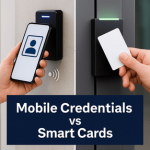
Private schools run on culture, trust, and smooth daily routines. Keys and scattered badge systems often work against that. Lost keys, weekend events, outside contractors, and after hours programs add risk and take time away from teaching and student life. Cloud based access control brings order, visibility, and speed without forcing a full rebuild of your campus.
This guide shows how a private school can move from keys to clicks in clear phases, using as much of your existing hardware as possible. It is designed for heads of school, operations leaders, and IT managers who want safer buildings and simpler workflows.
k
k
Why private schools are making the switch
-
Faster response. Lock or unlock from a phone or laptop.
-
Better control. Role based access for faculty, staff, students, coaches, vendors, and renters.
-
Clean records. Automatic entry logs for investigations, insurance, and audits.
-
Less friction. Fewer front office interruptions and no key ring chaos.
-
Future ready. Easy integration with visitor management, emergency alerts, and video surveillance.
k
k
Start with a quick reality check
Walk the campus and capture what you have now. Keep it simple.
-
Daily exterior entries for students and families
-
Special areas like labs, server rooms, nurse suite, chapel, and gym
-
After hours doors for athletics, arts, and rentals
-
Existing readers, strikes, controllers, and door hardware that still works
-
Who has keys and where they were duplicated
This inventory helps you keep what works and target upgrades that matter most.
k
k
A three phase roadmap that fits a private school calendar
Phase 1. Perimeter and front office
Focus on the doors that shape safety and experience every day.
-
Install cloud based controllers and readers on the main entries
-
Issue mobile or card credentials to faculty and staff
-
Create time based schedules for arrival, late entry, dismissal, and study hall
-
Add simple visitor check in with photo badges at reception
-
Train front office and division heads in fifteen minute sessions
Outcome: You remove master keys at the perimeter and end the daily door scramble.
Phase 2. Programs and special use spaces
Bring order to rooms with the most activity and risk.
-
Add readers to the gym, theater, weight room, labs, server room, and nurse suite
-
Use role based rules for coaches, arts faculty, student leaders, and club advisors
-
Build event schedules that open only the needed doors for practices and rehearsals
-
Tie in camera views at the most used entries for quick context
Outcome: You reduce tailgating and propped doors and gain reliable logs for high value spaces.
Phase 3. After hours and rentals
Support community use while academic areas stay protected.
-
Create lobby only routes for evening events and guest access
-
Issue time limited mobile credentials to rental leads and vendors
-
Enable on call remote unlocks for locked out coaches or performers
-
Use zone based emergency alerts so a gym incident does not alarm the whole campus
Outcome: Your campus remains welcoming while instruction areas remain secure.
k
k
Policies that make the technology work
-
Credential lifecycle. Issue on hire, auto expire on termination, renew annually at contract time.
-
Parent and student expectations. Explain when doors are open, where to enter, and why schedules matter.
-
Vendor standards. Require pre registration and time boxed credentials for anyone working on site.
-
Lost device plan. Revoke mobile credentials immediately and reissue with one click.
Clear rules keep the system clean and reduce help desk requests.
k
k
Integrations that matter for private schools
Visitor management
Scan ID for adult volunteers and vendors, print clear badges, and notify hosts instantly. Tie approved visitors to limited access credentials during the visit window.
Emergency alert systems
Give division heads and program leads a mobile panic button. Route alerts by zone to administrators, security, and local responders. Use plain language templates for staff and families.
Video surveillance
Cover main entries, lobbies, stairwells, and parking approaches. Cloud based video lets administrators review from home during weather closures or weekend events.
PA and digital signage
Display entry instructions during arrival and event wayfinding after hours. Prepare messages for lockdown, shelter, and all clear.
k
k
Budget and timeline tips
-
Start with the doors that move the most students
-
Reuse compatible readers and strikes to stretch budget
-
Plan installs during breaks and summer
-
Use access logs and incident reports to support insurance and grants
-
Standardize on one platform to reduce support costs
k
k
Security outcomes you can measure
-
Time from alert to door action during drills
-
Frequency and duration of propped doors by building and time of day
-
Number of lost key or badge incidents per quarter
-
Weekend and after hours entry trends for programs and rentals
-
Credential count by role with automated expirations
Share a short monthly scorecard with leadership to keep momentum.
k
k
Quick checklist for go live
-
Credentials issued to all staff and tested at the perimeter
-
Arrival and dismissal door schedules confirmed by division
-
Visitor check in and temporary credential workflow rehearsed
-
Emergency alert routing tested by zone
-
Camera views verified for key entries and public corridors
-
One page quick start cards at reception and security desk
k
k
How SSP supports private schools
SSP designs and supports integrated school security systems for private and independent schools. We help you phase in cloud based access control, connect visitor management, emergency alert systems, and video, and train your team by role so adoption is smooth. Our approach respects your culture, calendar, and campus layout.
Ready to move from keys to clicks
Request a short site review and we will outline a phased access control plan that fits your budget and your school year.


